Hippodrome statue bases of Porphyrios the greatest chairoteer of his age dating to 515
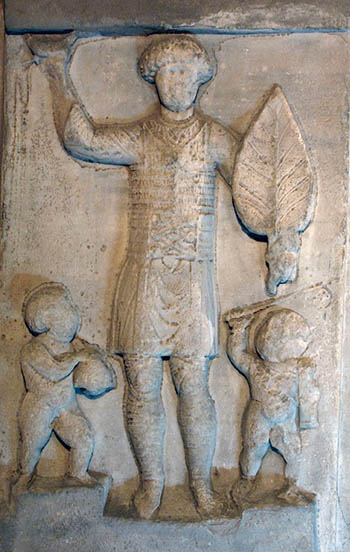
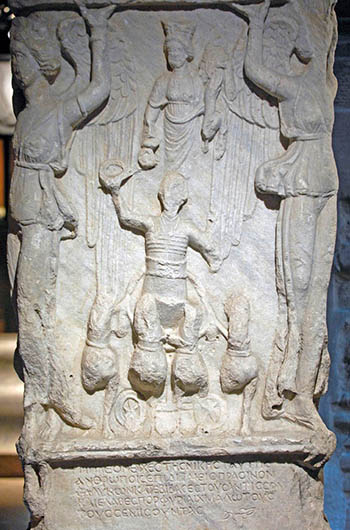
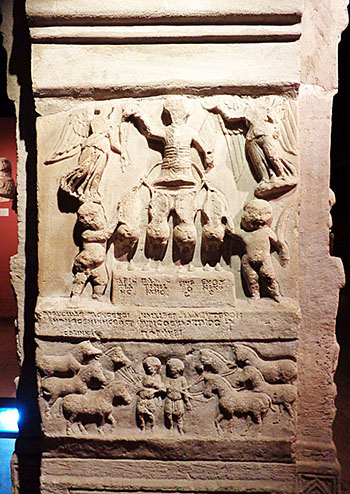

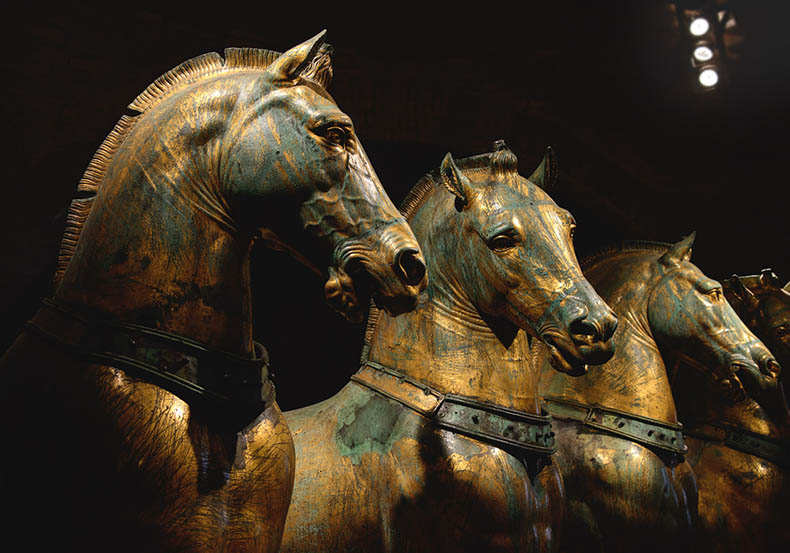 In Constantinople the famous horses were placed on top of the curved entrance to the Hippodrome, which was called the "Dippion", high above the ground. The Hippodrome was huge and filled with statuary and public monuments. This part of the it - the northern end - was used for public assemblies and festivals including dancing, dining and music and was an important public forum. Chariot racing was not the only attraction. Jugglers and acrobats were popular entertainment. There were performances of high-wire acts on cables strung from the Dippion to the obelisks on the Spina - the long "spine" running down the center of the Hippodrome. There were public executions here, too. Heretics were burned on huge piles of wood for the public to witness. Almost every citizen of the city would pass beneath the Dippion many times a year. The horses would have been among the most famous and popular works of art in Constantinople. The Byzantines were nuts about horse racing. Emperors competed in races and betting was one of the popular pastimes in the city. There were even special machines that could determine which team would win. Fans followed racers and horses. One emperor gave 100 pounds of gold to his favorite chariot rider and stood as godfather to his children.
In Constantinople the famous horses were placed on top of the curved entrance to the Hippodrome, which was called the "Dippion", high above the ground. The Hippodrome was huge and filled with statuary and public monuments. This part of the it - the northern end - was used for public assemblies and festivals including dancing, dining and music and was an important public forum. Chariot racing was not the only attraction. Jugglers and acrobats were popular entertainment. There were performances of high-wire acts on cables strung from the Dippion to the obelisks on the Spina - the long "spine" running down the center of the Hippodrome. There were public executions here, too. Heretics were burned on huge piles of wood for the public to witness. Almost every citizen of the city would pass beneath the Dippion many times a year. The horses would have been among the most famous and popular works of art in Constantinople. The Byzantines were nuts about horse racing. Emperors competed in races and betting was one of the popular pastimes in the city. There were even special machines that could determine which team would win. Fans followed racers and horses. One emperor gave 100 pounds of gold to his favorite chariot rider and stood as godfather to his children.
These four horses were lucky talismans and were believed to predict winners and bring luck to those who touched them. Bouquets of flowers were placed around their necks from grateful fans.
Pantomimes were performed in the Hippodrome and there were orchestras of trumpets, saxophones, drums and water organs to accompany them. There were spectacular fireworks and more than 300 ancient statues were displayed in the Hippodrome. The last chariot recorded race in Constantinople occurred in 1200 and was held in the courtyard of the Blachernae Palace. In 1203 the races ended when the west side of the Hippodrome went up in flames during the Fourth Crusade. You can learn more about the Hippodrome in Daily Life in 12th Century Constantinople and Sports in the Byzantium here.
You can learn more about the statues and monuments lost in 1204 here.
Benjamin of Tudela describes his visit to the Hippodrome in 1170:
"Close to the walls of the palace is also a place of amusement belonging to the king, which is called the Hippodrome, and every year on the anniversary of the birth of Jesus the king gives a great entertainment there. And in that place men from all the races of the world come before the king and queen with jugglery and without jugglery, and they introduce lions, leopards, bears, and wild asses, and they engage them in combat with one another; and the same thing is done with birds. No entertainment like this is to be found in any other land."
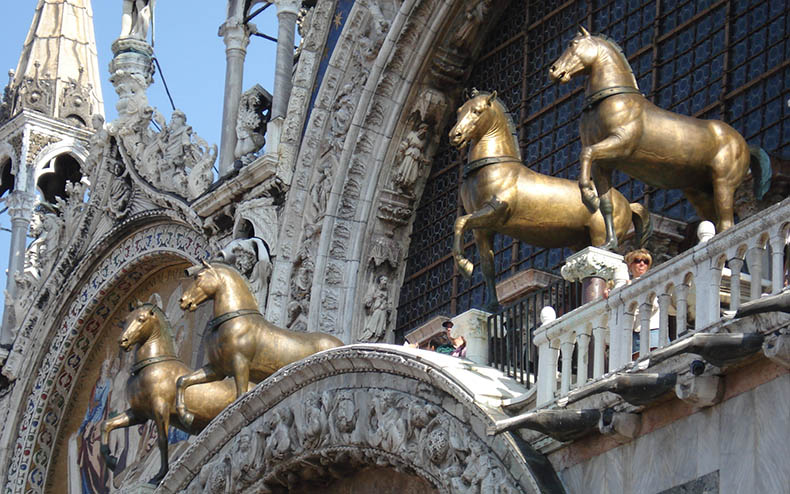 The horses would have had an especially dramatic position being so high and flashing in the sun from their gilding. They are over life-size, 7.5 feet tall and 8 feet long. The horses have fittings and studded harnesses that prove they were originally a part of a quadriga and would have faced out in two pairs. Each horse was cast in ten pieces and is unique in form. They were made using the last wax process. When they lost their chariot and its rider is unknown. Their size and the gilding would have have been impossible to ignore or take them for granted. The races began close by to fanfares of bronze and silver trumpets giving the space below the horses an especially festive setting. One cannot underestimate how important the horses were to public life in Constantinople. Foreigners, including the Venetian merchants who had their own quarter in the city would have known them very well.
The horses would have had an especially dramatic position being so high and flashing in the sun from their gilding. They are over life-size, 7.5 feet tall and 8 feet long. The horses have fittings and studded harnesses that prove they were originally a part of a quadriga and would have faced out in two pairs. Each horse was cast in ten pieces and is unique in form. They were made using the last wax process. When they lost their chariot and its rider is unknown. Their size and the gilding would have have been impossible to ignore or take them for granted. The races began close by to fanfares of bronze and silver trumpets giving the space below the horses an especially festive setting. One cannot underestimate how important the horses were to public life in Constantinople. Foreigners, including the Venetian merchants who had their own quarter in the city would have known them very well.
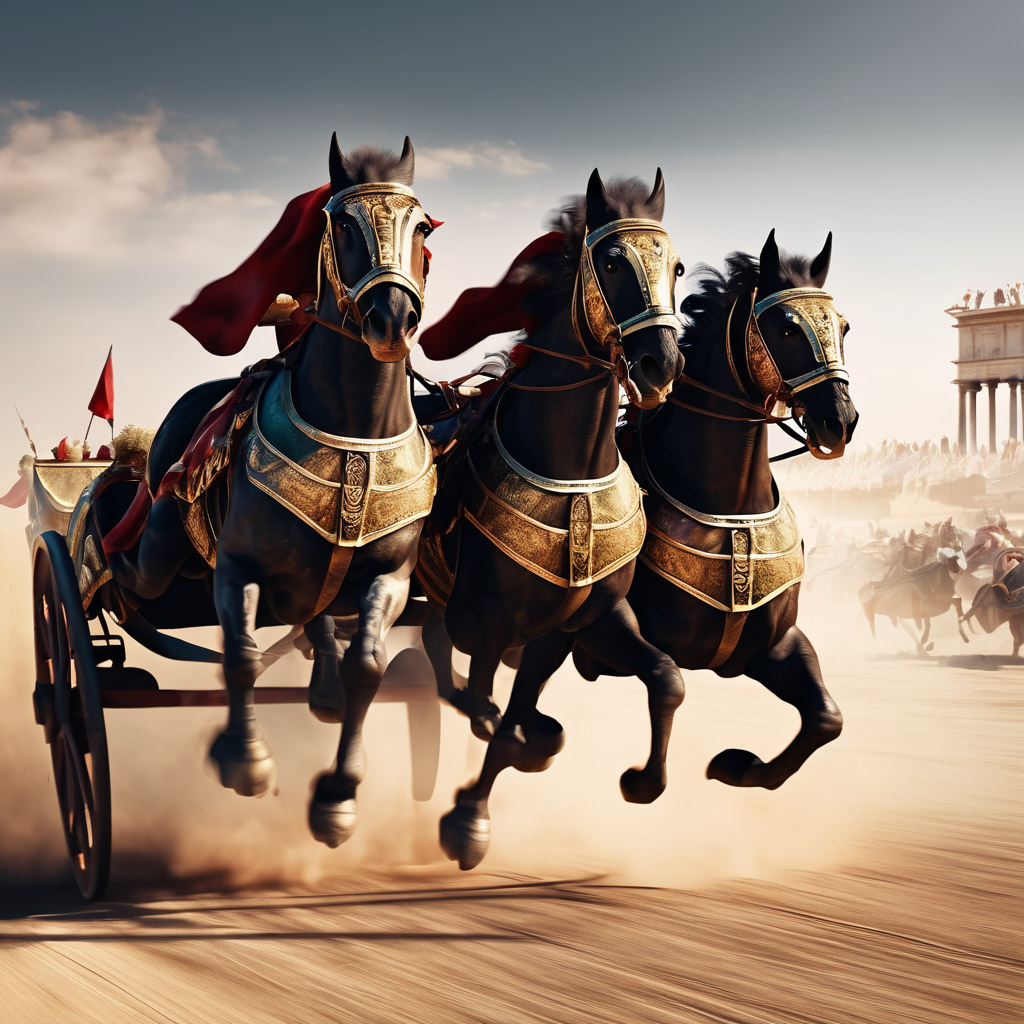 One of the problems with gilded statues was they could be blinding in the sun. The horses had their gilding abraded on the parts which faced the sun to bring down and soften the reflected light. The horses were far enough away and high enough that the scratches could not be seen by the public. When the horses were looted from Constantinople during the Fourth Crusade in 1204 the horses were removed from the Hippodrome and sent to Venice as booty. Doge Enrico Dandolo, or rather transported at his command on a Venetian ship commanded by Domenico Morosini. No one knew what to do with them since Dandalo had died in Constantinople in 1205 without sending instructions. The Morosinis ended up owning them. They sat in an open storage yard in the Arsenal for 50 years because the Venetians could not decide what to do with them. They almost got melted down. Reniero Zeno got the great idea to build a loggia on Saint Marks and display them there like they were mounted on a triumphal arch, thus performing could a similar role to the one they they had in Constantinople. They were placed on the front facade of Saint Mark's overlooking the square, with small marble columns holding up the feet. They instantly became a symbol of the city. The facade of Saint Marks was also covered with rare marble revetment, sculptures, columns and capitals taken from Constantinople as war booty.
One of the problems with gilded statues was they could be blinding in the sun. The horses had their gilding abraded on the parts which faced the sun to bring down and soften the reflected light. The horses were far enough away and high enough that the scratches could not be seen by the public. When the horses were looted from Constantinople during the Fourth Crusade in 1204 the horses were removed from the Hippodrome and sent to Venice as booty. Doge Enrico Dandolo, or rather transported at his command on a Venetian ship commanded by Domenico Morosini. No one knew what to do with them since Dandalo had died in Constantinople in 1205 without sending instructions. The Morosinis ended up owning them. They sat in an open storage yard in the Arsenal for 50 years because the Venetians could not decide what to do with them. They almost got melted down. Reniero Zeno got the great idea to build a loggia on Saint Marks and display them there like they were mounted on a triumphal arch, thus performing could a similar role to the one they they had in Constantinople. They were placed on the front facade of Saint Mark's overlooking the square, with small marble columns holding up the feet. They instantly became a symbol of the city. The facade of Saint Marks was also covered with rare marble revetment, sculptures, columns and capitals taken from Constantinople as war booty.
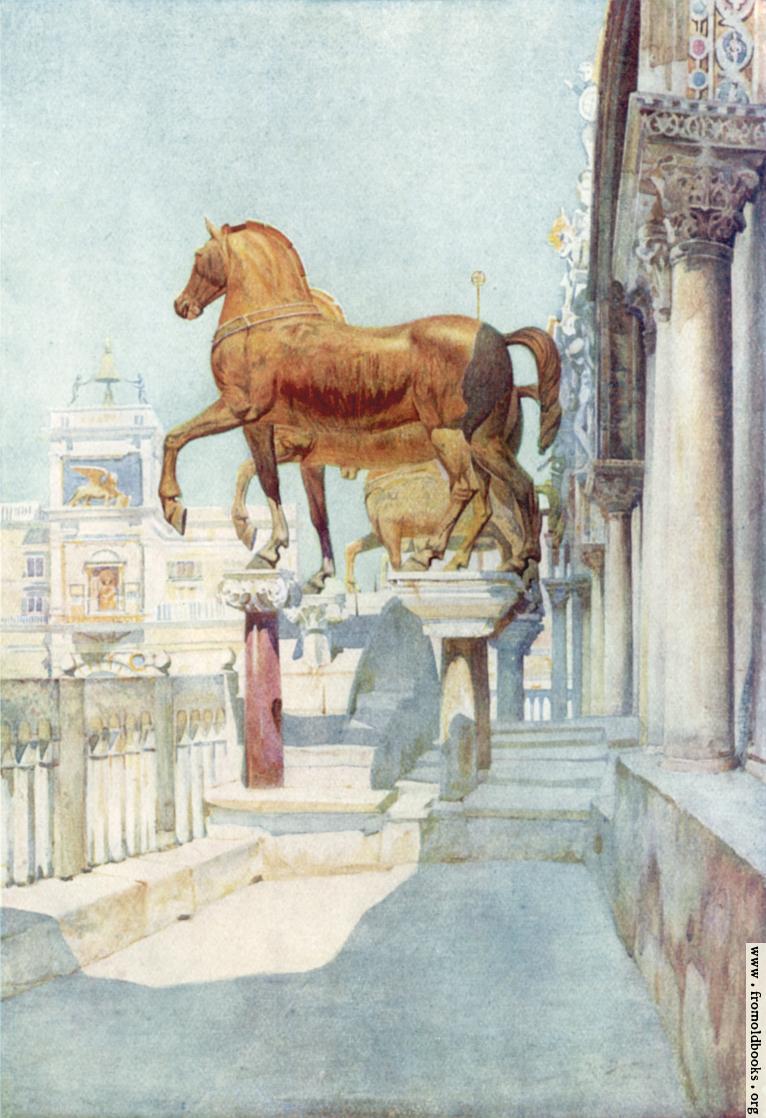
If you stood on the balcony looking out on the square you could see the the horses up close and see the scratches on their behinds. Visitors to Saint Marks always assumed that the scratches were a result of damage incurred in bringing them from Constantinople and placing them on the facade. This was a view that the people of Constantinople never had. As the ravages of pollution took their toll on them the scratches became darker and more obvious. Internally the horses were chewed up by decay and pollution and were in immediate danger of collapsing when it was decided to make copies and move the originals into a special museum. Now you can examine them up close and see how beautiful they are, the gilding and abrasion for yourself.
The great statue of Marcus Aurelius in Rome also had its mercury-gilded surfaces scratched up. It too has been replaced by a copy and moved inside a museum.
In this picture below you can plainly see the scratches on the most reflective surfaces of the horses.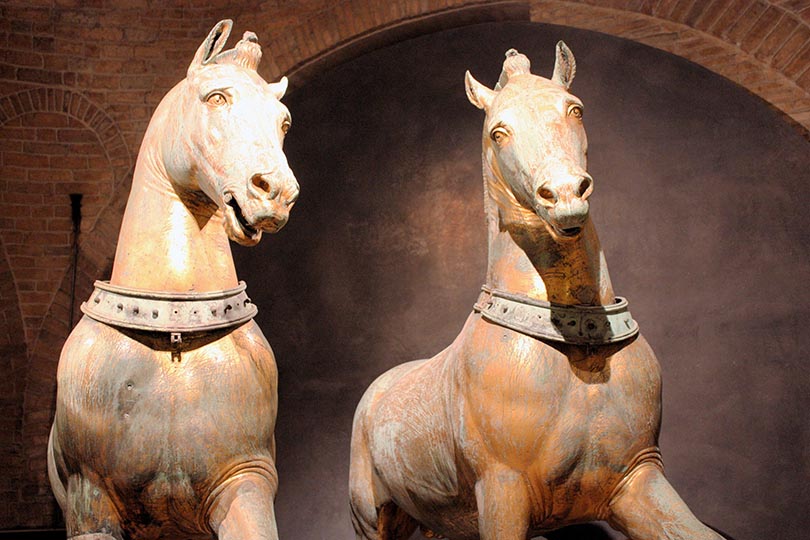
We aren't sure how old the horses are - some experts believe they date from the reign of Constantine and were made-to-order for Constantinople herself. A recent technical analysis has dated them from the 1st to 4th centuries - a very wide range. One of the features they point out to justify a late dating in the 4th century is the shape of the eyes, which is not "classical" in style. Monumental bronze casting on a huge scale was still being done in the 4th century reign of Constantine and there seems to have been no decline in the quality of the casting. The Byzantines told the story they they were cast by Theodosios II (408-50) and were brought from the island of Chios. Were they part of a quadriga? Since the hippodrome was built in the reign of Septimus Severus, were the horses a part of the original project? Up until 1204 there were many bronze equestrian statues in Constantinople, which were identified by the names of their riders who were all emperors of Rome and Constantinople. The records also tell us whether they were gilded or not. The horses of Saint Marks are the only ones to survive from Byzantium.
Roman bronze casting was amazing and their techniques were not rivaled in the West until the 17th century. Roman bronzes were very thinly cast and assembled from many pieces fused together. The cost of bronze was very high and they wanted it to go as far as possible. By testing the metal content of Greek and Roman bronzes we can tell where they were made. Roman bronze is made of tin, copper and lead. There were some trace elements but the Romans were remarkably consistent in the formula for bronze casting for hundreds of years. One can assume that Greek and Roman bronze casting was perfected to produce stuff for the military and navy on an industrial scale. Even in the Byzantine period we know that hundreds of thousands of bronze arrows, spears, swords, armor and helmets could be produced fast and efficiently. All of the 10th-12th century Byzantine doors that survive today are actually cast and fashioned in leaded brass, not bronze.




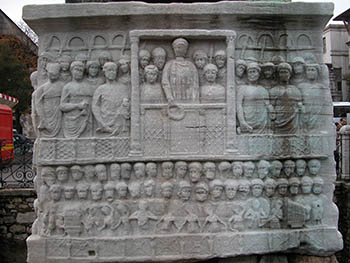
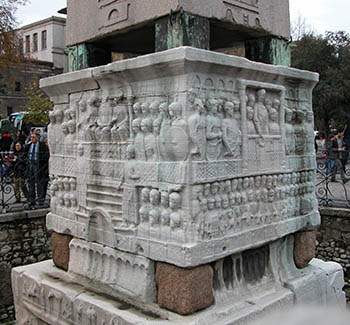



 click here for icons of christ
click here for icons of christ click here for icons of the theotokos
click here for icons of the theotokos click here for icons of angels
click here for icons of angels click here for icons of saints
click here for icons of saints